Sierra Wireless HL7588 Wireless Module User Manual Hardware Integration Guide
Sierra Wireless Inc. Wireless Module Hardware Integration Guide
Contents
- 1. Users Manual
- 2. HL7588 Accessory Board - Hardware Integration Guide - Rev1.1
- 3. Instruction Manual
HL7588 Accessory Board - Hardware Integration Guide - Rev1.1
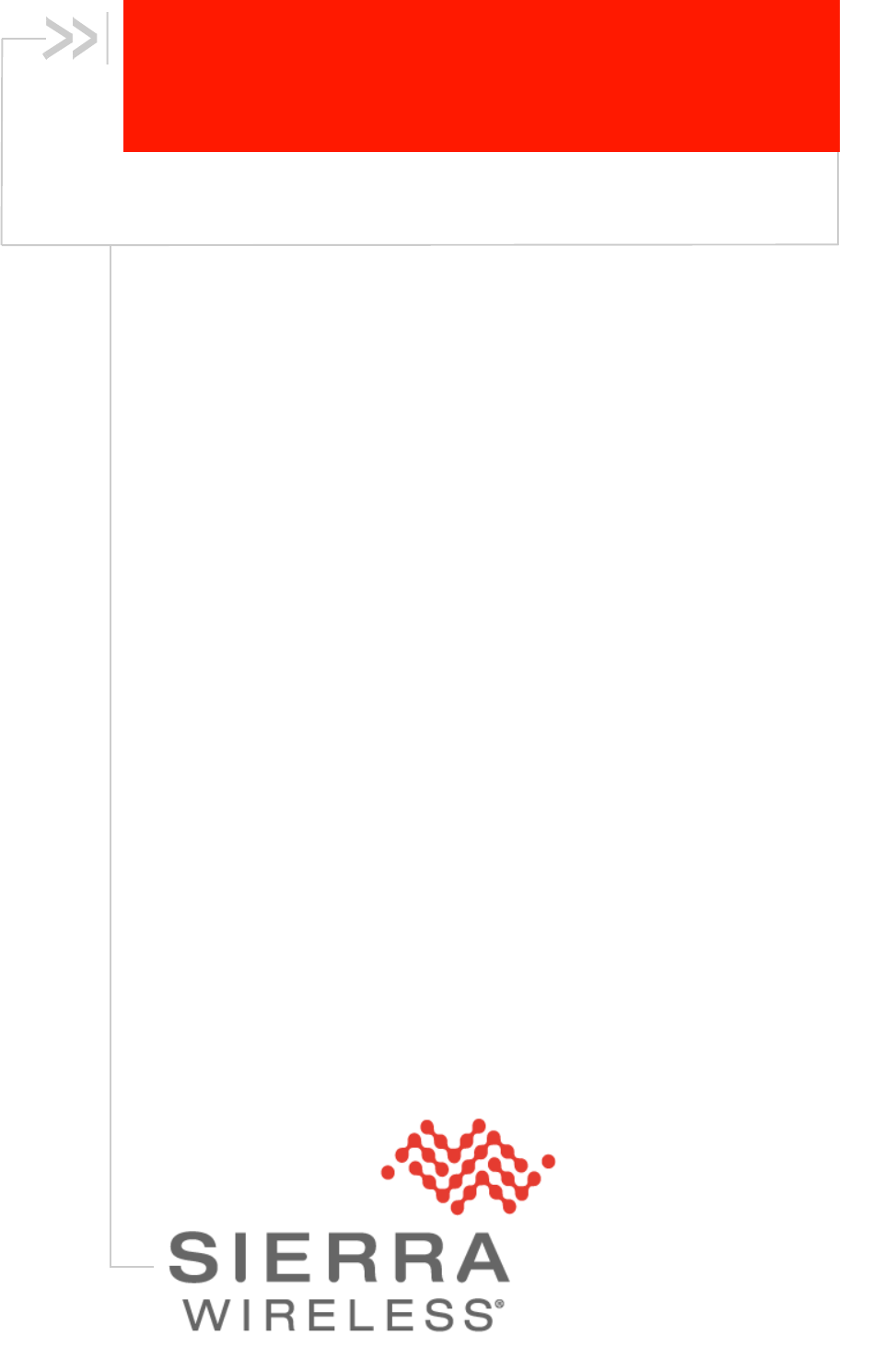
4119383
1.1
June 06, 2016
AirPrime HL7588 Accessory Board
Hardware Integration Guide

4119383 Rev 1.1 June 06, 2016 2
Hardware Integration Guide
Important Notice
Due to the nature of wireless communications, transmission and reception of data can never be
guaranteed. Data may be delayed, corrupted (i.e., have errors) or be totally lost. Although significant
delays or losses of data are rare when wireless devices such as the Sierra Wireless modem are used
in a normal manner with a well-constructed network, the Sierra Wireless modem should not be used
in situations where failure to transmit or receive data could result in damage of any kind to the user or
any other party, including but not limited to personal injury, death, or loss of property. Sierra Wireless
accepts no responsibility for damages of any kind resulting from delays or errors in data transmitted or
received using the Sierra Wireless modem, or for failure of the Sierra Wireless modem to transmit or
receive such data.
Safety and Hazards
Do not operate the Sierra Wireless modem in areas where cellular modems are not advised without
proper device certifications. These areas include environments where cellular radio can interfere such
as explosive atmospheres, medical equipment, or any other equipment which may be susceptible to
any form of radio interference. The Sierra Wireless modem can transmit signals that could interfere
with this equipment. Do not operate the Sierra Wireless modem in any aircraft, whether the aircraft is
on the ground or in flight. In aircraft, the Sierra Wireless modem MUST BE POWERED OFF. When
operating, the Sierra Wireless modem can transmit signals that could interfere with various onboard
systems.
Note: Some airlines may permit the use of cellular phones while the aircraft is on the ground and the door
is open. Sierra Wireless modems may be used at this time.
The driver or operator of any vehicle should not operate the Sierra Wireless modem while in control of
a vehicle. Doing so will detract from the driver or operator’s control and operation of that vehicle. In
some states and provinces, operating such communications devices while in control of a vehicle is an
offence.
Limitations of Liability
This manual is provided “as is”. Sierra Wireless makes no warranties of any kind, either expressed or
implied, including any implied warranties of merchantability, fitness for a particular purpose, or
noninfringement. The recipient of the manual shall endorse all risks arising from its use.
The information in this manual is subject to change without notice and does not represent a
commitment on the part of Sierra Wireless. SIERRA WIRELESS AND ITS AFFILIATES
SPECIFICALLY DISCLAIM LIABILITY FOR ANY AND ALL DIRECT, INDIRECT, SPECIAL,
GENERAL, INCIDENTAL, CONSEQUENTIAL, PUNITIVE OR EXEMPLARY DAMAGES INCLUDING,
BUT NOT LIMITED TO, LOSS OF PROFITS OR REVENUE OR ANTICIPATED PROFITS OR
REVENUE ARISING OUT OF THE USE OR INABILITY TO USE ANY SIERRA WIRELESS
PRODUCT, EVEN IF SIERRA WIRELESS AND/OR ITS AFFILIATES HAS BEEN ADVISED OF THE
POSSIBILITY OF SUCH DAMAGES OR THEY ARE FORESEEABLE OR FOR CLAIMS BY ANY
THIRD PARTY.
Notwithstanding the foregoing, in no event shall Sierra Wireless and/or its affiliates aggregate liability
arising under or in connection with the Sierra Wireless product, regardless of the number of events,
occurrences, or claims giving rise to liability, be in excess of the price paid by the purchaser for the
Sierra Wireless product.
Customer understands that Sierra Wireless is not providing cellular or GPS (including A-GPS)
services. These services are provided by a third party and should be purchased directly by the
Customer.

4119383 Rev 1.1 June 06, 2016 3
Hardware Integration Guide
SPECIFIC DISCLAIMERS OF LIABILITY: CUSTOMER RECOGNIZES AND ACKNOWLEDGES
SIERRA WIRELESS IS NOT RESPONSIBLE FOR AND SHALL NOT BE HELD LIABLE FOR ANY
DEFECT OR DEFICIENCY OF ANY KIND OF CELLULAR OR GPS (INCLUDING A-GPS)
SERVICES.
Patents
This product may contain technology developed by or for Sierra Wireless Inc.
This product includes technology licensed from QUALCOMM®.
This product is manufactured or sold by Sierra Wireless Inc. or its affiliates under one or more patents
licensed from InterDigital Group and MMP Portfolio Licensing.
Copyright
© 2016 Sierra Wireless. All rights reserved.
Trademarks
Sierra Wireless®, AirPrime®, AirLink®, AirVantage®, WISMO®, ALEOS® and the Sierra Wireless and
Open AT logos are registered trademarks of Sierra Wireless, Inc. or one of its subsidiaries.
Watcher® is a registered trademark of NETGEAR, Inc., used under license.
Windows® and Windows Vista® are registered trademarks of Microsoft Corporation.
Macintosh® and Mac OS X® are registered trademarks of Apple Inc., registered in the U.S. and other
countries.
QUALCOMM® is a registered trademark of QUALCOMM Incorporated. Used under license.
Other trademarks are the property of their respective owners.
Contact Information
Sales Desk:
Phone:
1-604-232-1488
Hours:
8:00 AM to 5:00 PM Pacific Time
Contact:
http://www.sierrawireless.com/sales
Post:
Sierra Wireless
13811 Wireless Way
Richmond, BC
Canada V6V 3A4
Technical Support:
support@sierrawireless.com
RMA Support:
repairs@sierrawireless.com
Fax:
1-604-231-1109
Web:
http://www.sierrawireless.com/
Consult our website for up-to-date product descriptions, documentation, application notes, firmware
upgrades, troubleshooting tips, and press releases: www.sierrawireless.com

4119383 Rev 1.1 June 06, 2016 4
Hardware Integration Guide
Document History
Version
Date
Updates
1.0
June 01, 2016
Creation
1.1
June 06, 2016
Removed Power Up Sequence

4119383 Rev 1.1 June 06, 2016 5
Contents
1. INTRODUCTION .................................................................................................. 8
2. POWER INTERFACE ........................................................................................... 9
2.1. Power Supply .................................................................................................................... 9
2.2. Power Off Sequence ......................................................................................................... 9
2.3. Sleep Mode Management ................................................................................................. 9
3. RF INTERFACE .................................................................................................. 10
3.1. Supported RF Bands ....................................................................................................... 10
3.2. RF Connection ................................................................................................................. 10
3.3. RF Performances ............................................................................................................ 11
3.4. TX_ON Indicator .............................................................................................................. 11
4. ESD GUIDELINES .............................................................................................. 12
4.1. SIM Card ......................................................................................................................... 12
4.2. USB ................................................................................................................................. 13
5. FCC REGULATIONS ......................................................................................... 14
6. REFERENCES ................................................................................................... 16
6.1. Reference Documents ..................................................................................................... 16
6.2. Terms and Abbreviations................................................................................................. 16

4119383 Rev 1.1 June 06, 2016 6
List of Figures
Figure 1. TX_ON State During Transmission ................................................................................. 11
Figure 2. EMC and ESD Components Close to the SIM ................................................................ 12
Figure 3. ESD Protection for USB .................................................................................................. 13

4119383 Rev 1.1 June 06, 2016 7
List of Tables
Table 1. Power Supply .................................................................................................................... 9
Table 2. Supported Bands ............................................................................................................. 10
Table 3. RF Main Connection ........................................................................................................ 10
Table 4. RF Diversity Connection .................................................................................................. 10
Table 5. Conducted RX Sensitivity (dBm) ..................................................................................... 11
Table 6. TX_ON Indicator Description ........................................................................................... 11
Table 7. TX_ON Characteristics .................................................................................................... 11

4119383 Rev 1.1 June 06, 2016 8
1. Introduction
The AirPrime HL7588 Accessory Board belongs to the AirPrime MC Series product family and
provides data connectivity on wireless networks as listed in Table 2 Supported Bands.
The HL7588 Accessory Board supports a large variety of interfaces such as USB 2.0, UART, GPIOs,
and SIM to provide customers with the highest level of flexibility in implementing high-end solutions.

4119383 Rev 1.1 June 06, 2016 9
2. Power Interface
2.1. Power Supply
The AirPrime HL7588 Accessory Board is supplied through the VBAT signal.
Table 1. Power Supply
Pin Numbers
Supply
Minimum
Typical
Maximum
2, 24, 39, 41, 52
VBAT voltage (V)
3.2*
3.7
4.5
* This value has to be guaranteed during the burst.
Note: Load capacitance for VBAT is around 32µF ± 20% embedded inside the accessory board.
2.2. Power Off Sequence
To power the HL7588 Accessory Board off:
1. Put the accessory board in low power mode (LPM) by sending either AT+KSLEEP=1 or
AT+CPWROFF=1.
2. Wait for at least 10 seconds.
3. Remove the power supply to VBAT.
2.3. Sleep Mode Management
Use AT+KSLEEP=1 to allow the accessory board to automatically enter sleep mode while the USB
interface is in use.
When AT+KSLEEP=2, the accessory board will never enter sleep mode.
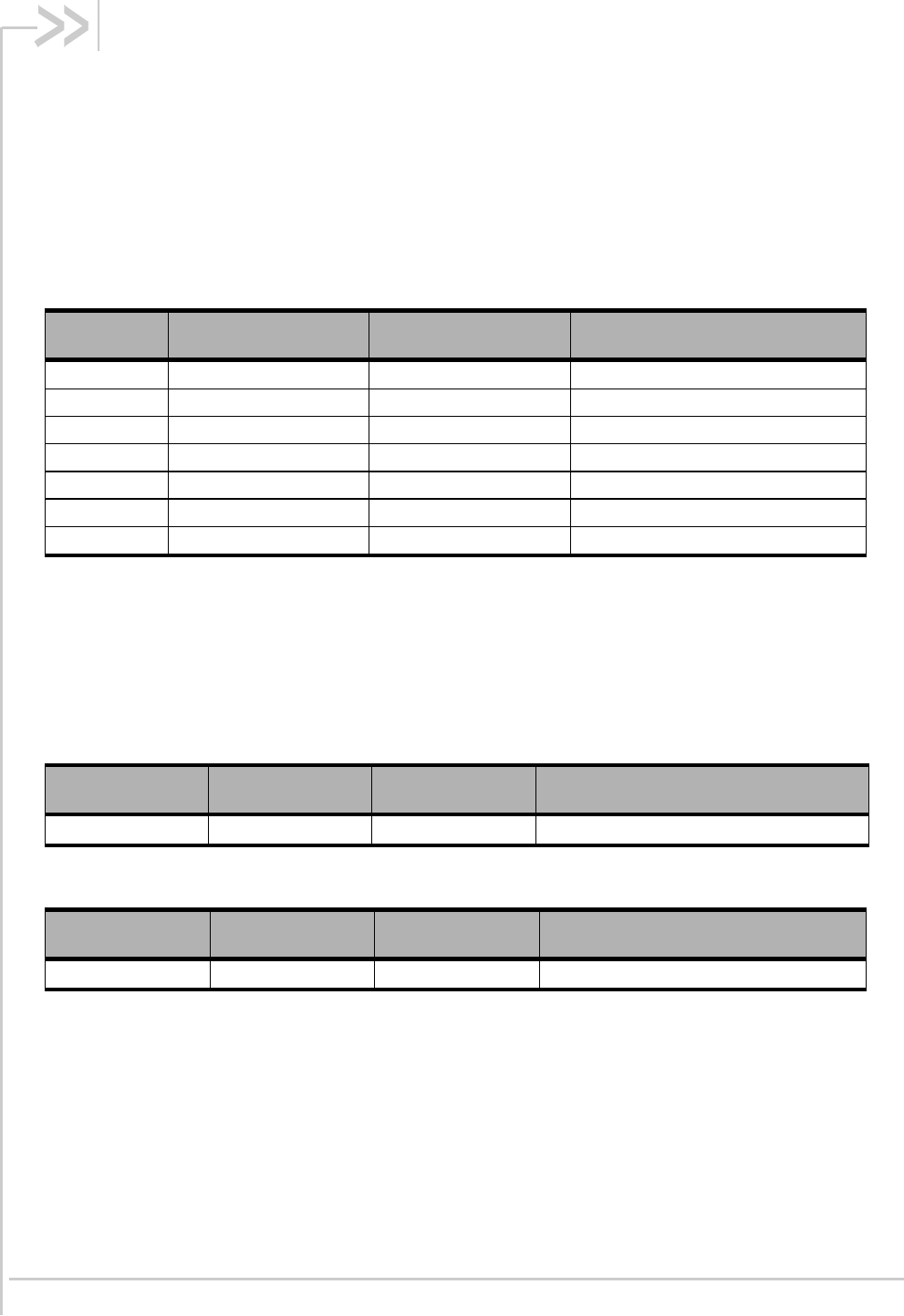
4119383 Rev 1.1 June 06, 2016 10
3. RF Interface
The RF interface of the HL7588 Accessory Board allows the transmission of RF signals. This interface
has a 50Ω nominal impedance.
3.1. Supported RF Bands
The HL7588 Accessory Board supports the RF bands listed in the table below.
Table 2. Supported Bands
RF Band
Transmit Band (Tx)
Receive Band (Rx)
Maximum Output Power
LTE B2
1850 to 1910 MHz
1930 to 1990 MHz
22.5 dBm (+/- 2dBm) Class 3bis
LTE B4
1710 to 1755 MHz
2110 to 2155 MHz
22.5 dBm (+/- 2dBm) Class 3bis
LTE B5
824 to 849 MHz
869 to 894 MHz
22.5 dBm (+/- 2dBm) Class 3bis
LTE B13
777 to 787 MHz
746 to 756 MHz
22.5 dBm (+/- 2dBm) Class 3bis
LTE B17
704 to 716 MHz
734 to 746 MHz
22.5 dBm (+/- 2dBm) Class 3bis
UMTS B2
1850 to 1910 MHz
1930 to 1990 MHz
22.5 dBm (+/- 2dBm) Class 3bis
UMTS B5
824 to 849 MHz
869 to 894 MHz
22.5 dBm (+/- 2dBm) Class 3bis
3.2. RF Connection
A 50Ω stripline can be used to connect to standard RF connectors such as SMA, UFL, etc. for
antenna connection.
Table 3. RF Main Connection
RF Signal
Impedance
VSWR Rx (max)
VSWR Tx (max)
RF_MAIN
50Ω
1.5:1
1.5:1
Table 4. RF Diversity Connection
RF Signal
Impedance
VSWR Rx (max)
VSWR Tx (max)
RF_DIV
50Ω
1.5:1
---
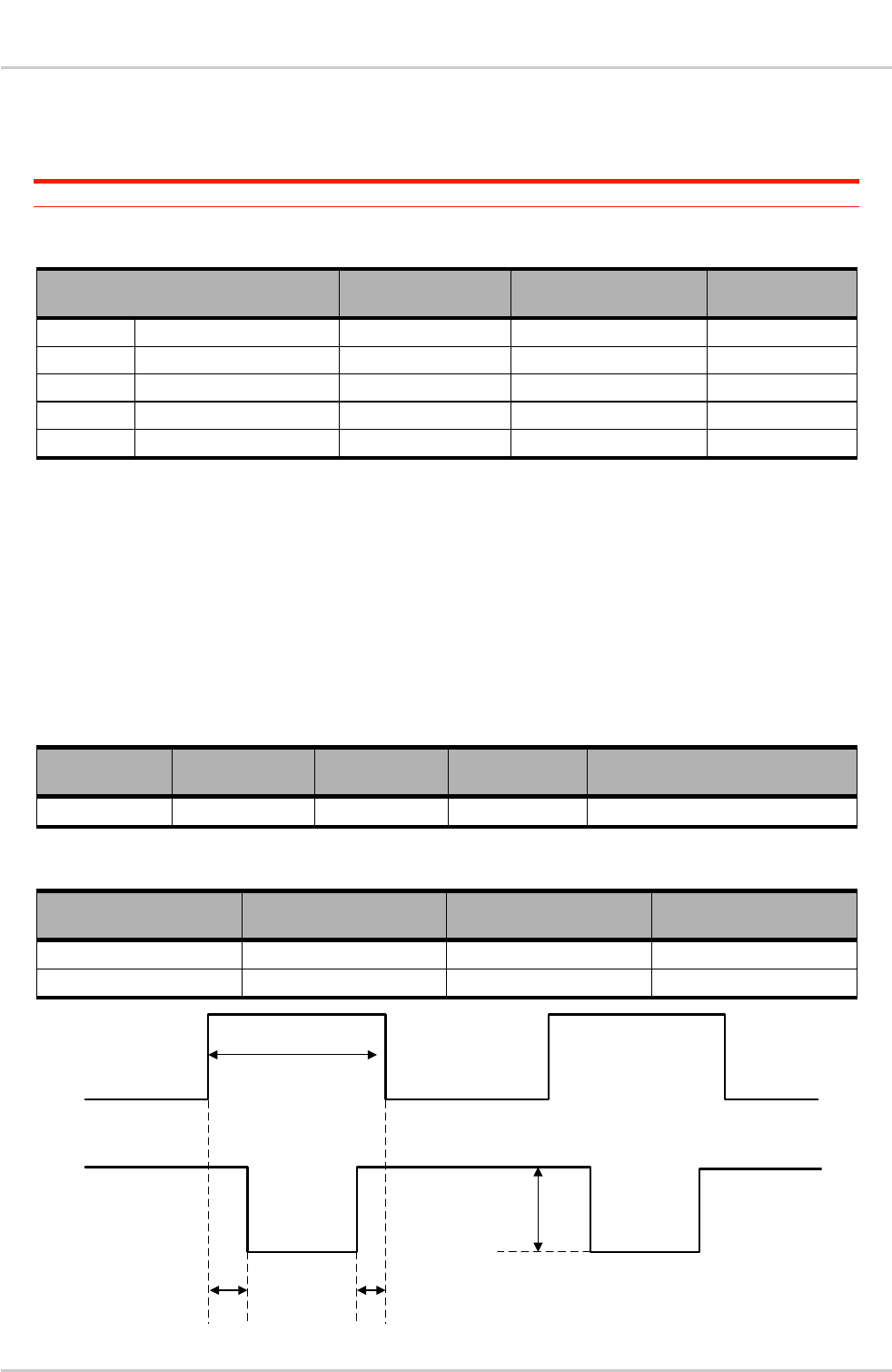
4119383 Rev 1.1 June 06, 2016 11
Hardware Integration Guide
RF Interface
3.3. RF Performances
RF performances are compliant with 3GPP recommendation TS 36.101.
Note: Values in the table below are preliminary and subject to change.
Table 5. Conducted RX Sensitivity (dBm)
Frequency Band
Primary (Typical)
Secondary (Typical)
SIMO (Typical)
LTE B2
Full RB; BW: 20 MHz*
-92.5
-92.5
-95.5
LTE B4
Full RB; BW: 20 MHz*
-94.5
-94.5
-97.5
LTE B5
Full RB; BW: 10 MHz*
-97.5
-98.5
-101.5
LTE B13
Full RB; BW: 10 MHz*
-97.5
-98.5
-101.5
LTE B17
Full RB; BW: 10 MHz*
-97.5
-98.5
-101.5
* Sensitivity values scale with bandwidth: x_MHz_Sensitivity = 10 MHz_Sensitivity – 10*log (10 MHz/x_MHz)
3.4. TX_ON Indicator
The AirPrime HL7588 Accessory Board provides a signal, 2G_TX_ON, for TX indication. 2G_TX_ON
is a 2.3V signal and its status signal depends on the accessory board’s transmitter state.
Refer to the following table for the status of the 2G_TX_ON signal depending on the HL7588
Accessory Board’s state.
Table 6. TX_ON Indicator Description
Pin Number
Signal Name
Function
I/O type
Power Supply Domain
42
2G_TX_ON
TX indicator
O
2.3V
Table 7. TX_ON Characteristics
Parameter
Minimum
Typical
Maximum
Tadvance
30µs
Tdelay
10µs
TX_ON
VBATT_PA
T duration
T advance T delay
Voltage drop
Figure 1. TX_ON State During Transmission
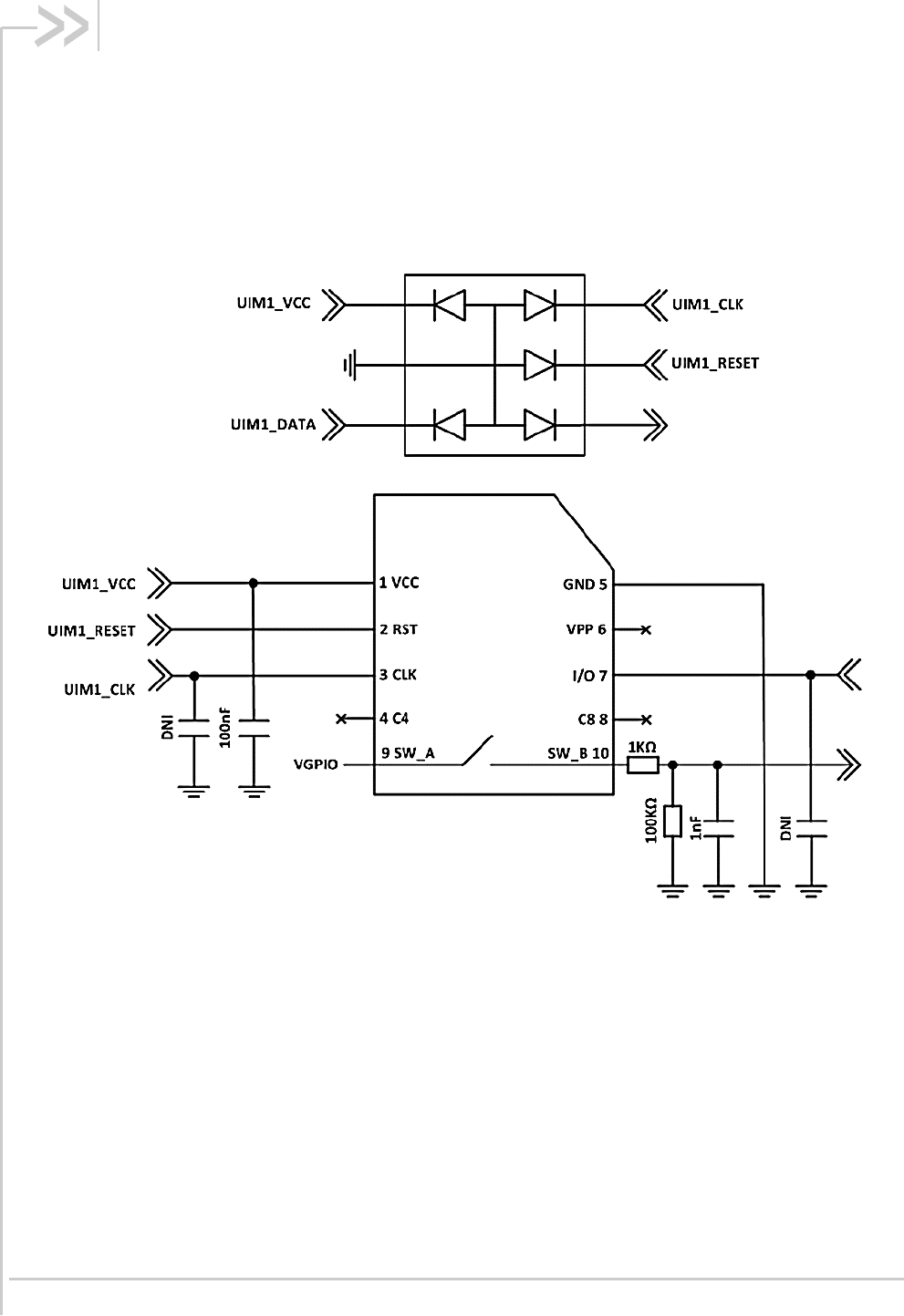
4119383 Rev 1.1 June 06, 2016 12
4. ESD Guidelines
4.1. SIM Card
Decoupling capacitors must be added according to the drawings below as close as possible to the
SIM card connectors on UIM1_CLK, UIM1_RST, UIM1_VCC and UIM1_DATA signals to avoid EMC
issues and to comply with the requirements of ETSI and 3GPP standards covering the SIM electrical
interface.
A typical schematic including SIM detection is provided below.
Figure 2. EMC and ESD Components Close to the SIM
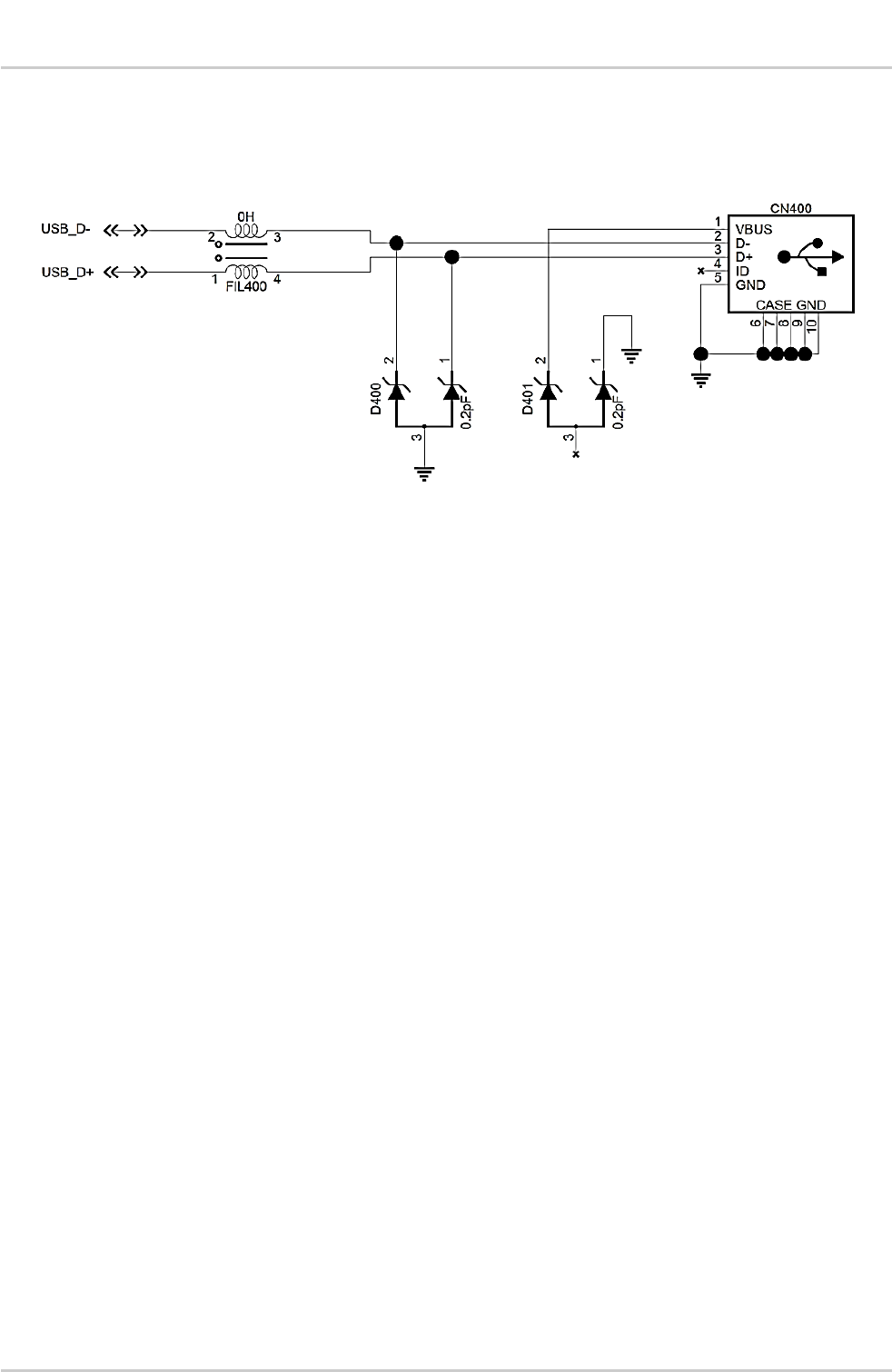
4119383 Rev 1.1 June 06, 2016 13
Hardware Integration Guide
ESD Guidelines
4.2. USB
When the USB interface is externally accessible, it is required to have ESD protection on the USB_D+
and USB_D- signals.
Figure 3. ESD Protection for USB
Sierra Wireless recommends using a 90Ω DLP0NSN900HL2L EMC filter and an RCLAMP0503N or
ESD5V3U2U-03LRH ESD diode.
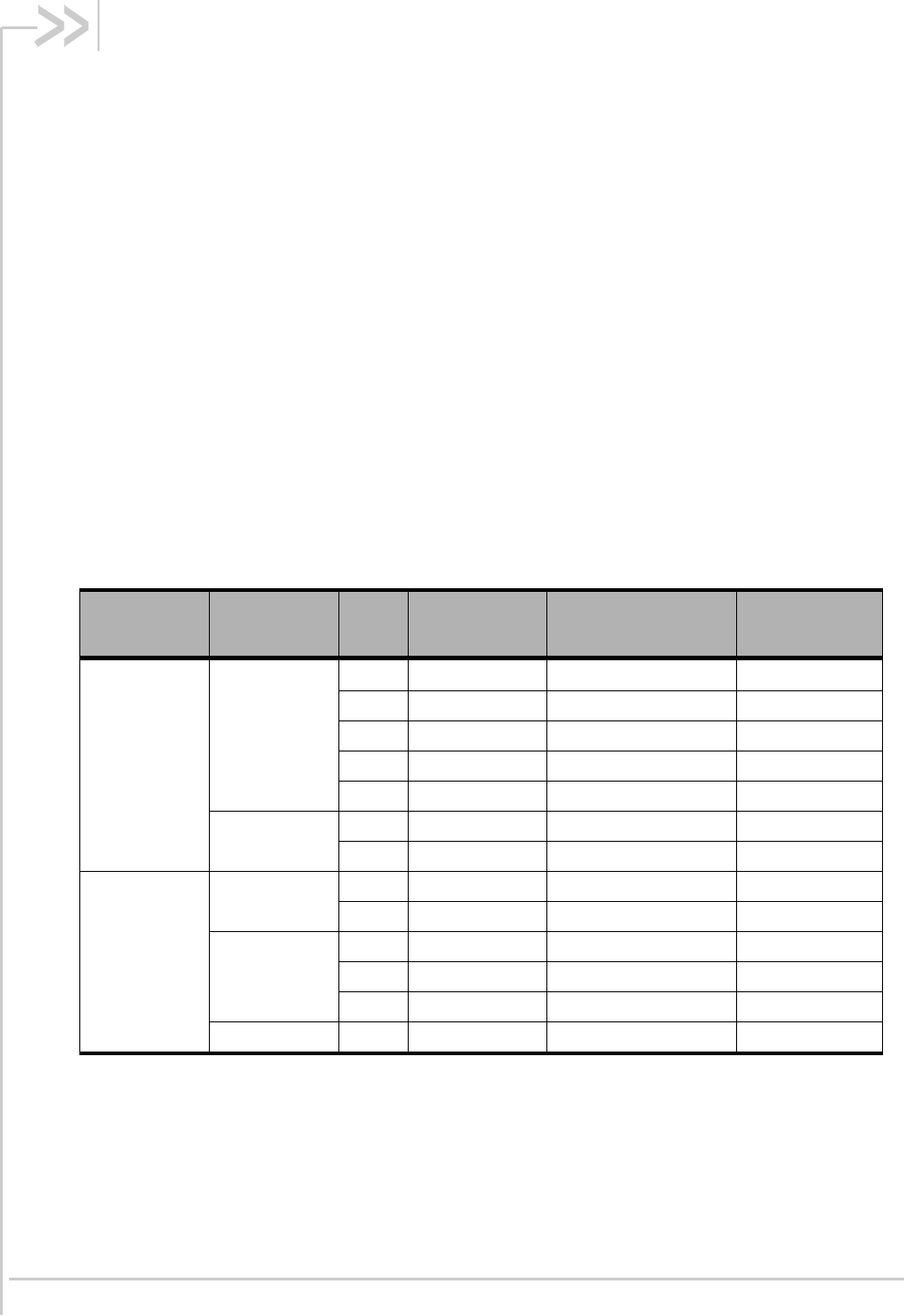
4119383 Rev 1.1 June 06, 2016 14
5. FCC Regulations
The HL7588 Accessory Board has been granted modular approval for mobile applications. Integrators
may use the HL7588 Accessory Board in their final products without additional FCC certification if
they meet the following conditions. Otherwise, additional FCC approvals must be obtained.
1. At least 20 cm separation distance between the antenna and the user’s body must be
maintained at all times.
2. To comply with FCC regulations limiting both maximum RF output power and human
exposure to RF radiation, the maximum antenna gain including cable loss in a mobile-only
exposure condition must not exceed:
7.5 dBi in Band 2
5.0 dBi in Band 4
9.0 dBi in Band 5
9.0 dBi in Band 13
9.0 dBi in Band 17
3. The AR7552 modem may transmit simultaneously with other collocated radio
transmitters within a host device, provided the following conditions are met:
Each collocated radio transmitter has been certfied by FCC / IC for mobile application.
At least 20 cm separation distance between the antennas of the collocated transmitters
and the user’s body must be maintained at all times.
The output power and antenna gain must not exceed the limits and configurations
stipulated in the following table.
Device
Technology
Band
Frequency
(MHz)
Maximum
conducted power
Maximum
antenna gain
HL7588
Module
LTE
2
1850-1910
24.5
6.5
4
1710-1755
24.5
7.5
5
824-849
24.5
7.5
13
777–787
24.5
5.0
17
704-716
24.5
6.5
UMTS
2
1850-1910
24.5
6.0
5
824-849
24.5
6.0
Collocated
transmitters1
WLAN
2400-2500
29
5
5150-580
29
5
WiMAX
2300-2400
29
5
2500-2700
29
5
3300-3800
29
5
BT
2400-2500
15
5
4. The HL7588 Accessory Board must not transmit simultaneously with other collocated radio
transmitters within a host device.
5. The RF signal must be routed on the application board using tracks with a 50Ω characteristic
impedance. Basically, the characteristic impedance depends on the dielectric, the track width
and the ground plane spacing. In order to respect this constraint, Sierra Wireless
recommends using MicroStrip or StripLine structure and computing the Tracks width with a
simulation tool (like AppCad shown in the figure below and that is available free of charge at
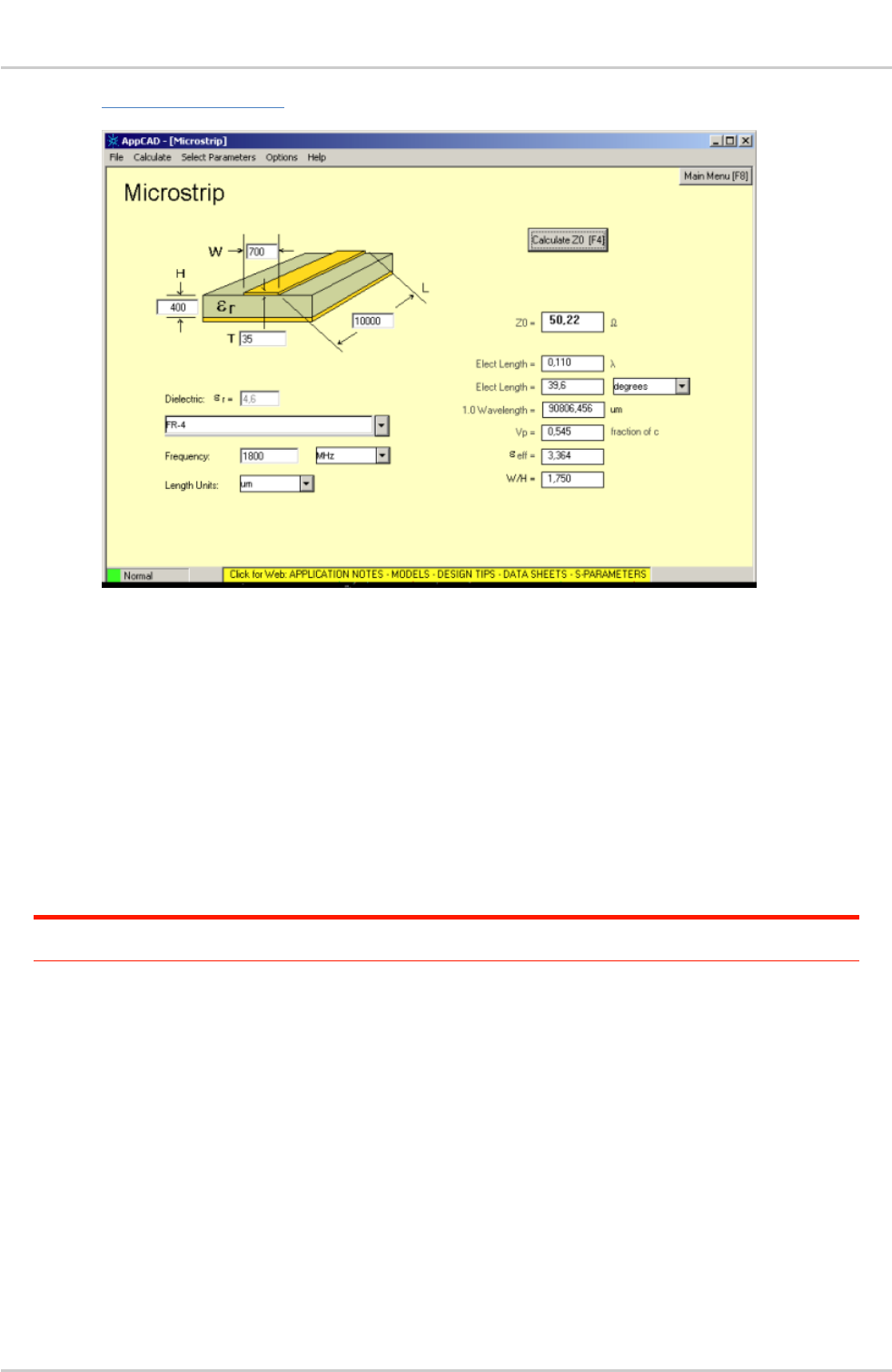
4119383 Rev 1.1 June 06, 2016 15
Hardware Integration Guide
FCC Regulations
http://www.agilent.com).
If a multi-layered PCB is used, the RF path on the board must not cross any signal (digital,
analog or supply).
6. A label must be affixed to the outside of the end product into which the HL7588 Accessory
Board is incorporated, with a statement similar to the following:
This device contains FCC ID: N7NHL7588
7. A user manual with the end product must clearly indicate the operating requirements and
conditions that must be observed to ensure compliance with current FCC RF exposure
guidelines.
The end product with an embedded HL7588 Accessory Board may also need to pass the FCC Part 15
unintentional emission testing requirements and be properly authorized per FCC Part 15.
Note: If this accessory board is intended for use in a portable device, you are responsible for separate
approval to satisfy the SAR requirements of FCC Part 2.1093.
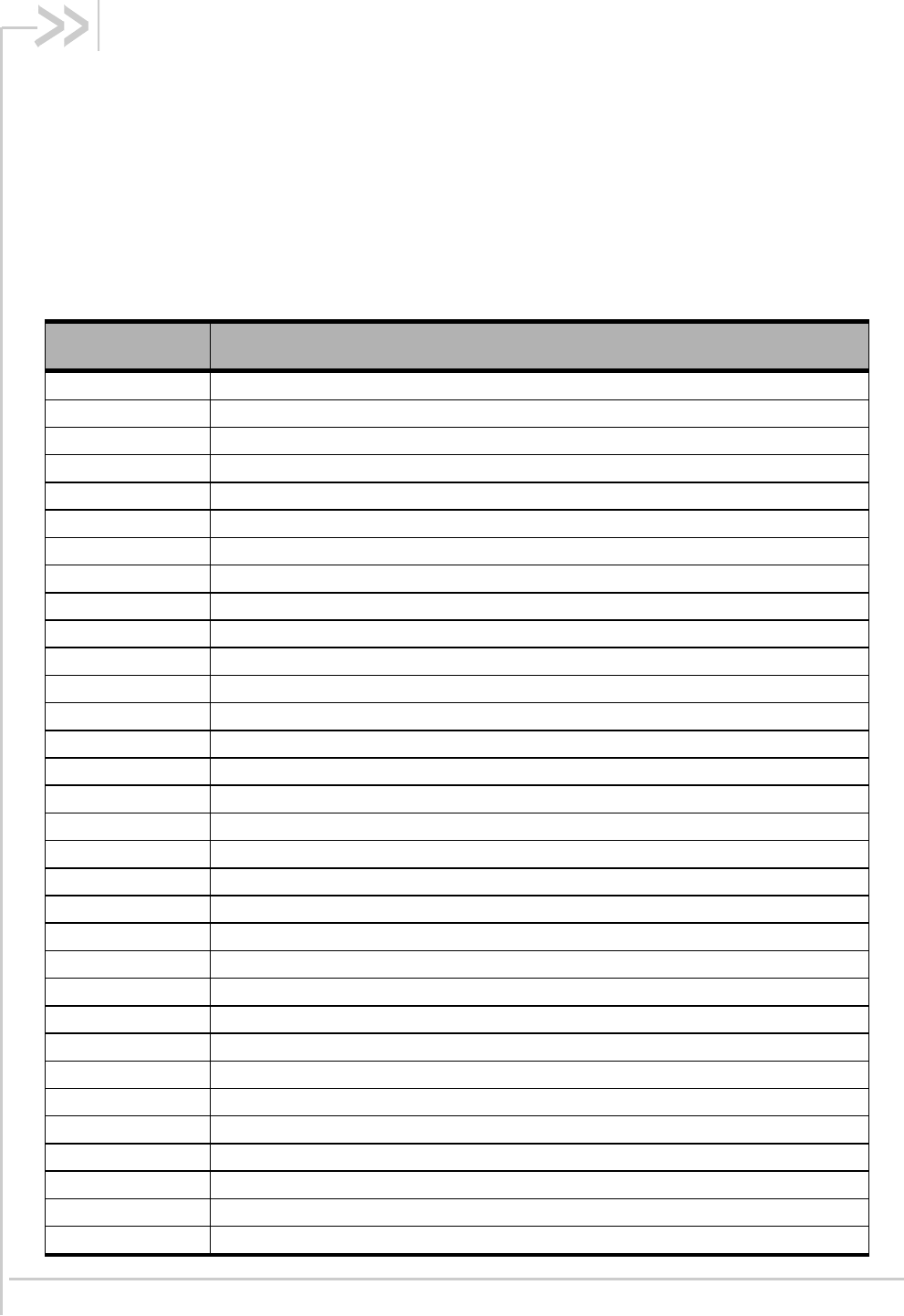
4119383 Rev 1.1 June 06, 2016 16
6. References
6.1. Reference Documents
[1] AirPrime HL7588 Accessory Board Product Technical Specification
Reference number: 4119052
6.2. Terms and Abbreviations
Abbreviation
Definition
ADC
Analog to Digital Converter
AGC
Automatic Gain Control
AT
Attention (prefix for modem commands)
CDMA
Code Division Multiple Access
CF3
Common Flexible Form Factor
CLK
Clock
CODEC
Coder Decoder
CPU
Central Processing Unit
DAC
Digital to Analog Converter
DTR
Data Terminal Ready
EGNOS
European Geostationary Navigation Overlay Service
EMC
Electromagnetic Compatibility
EMI
Electromagnetic Interference
EN
Enable
ESD
Electrostatic Discharges
ETSI
European Telecommunications Standards Institute
FDMA
Frequency-division multiple access
GAGAN
GPS aided geo augmented navigation
GLONASS
Global Navigation Satellite System
GND
Ground
GNSS
Global Navigation Satellite System
GPIO
General Purpose Input Output
GPRS
General Packet Radio Service
GSM
Global System for Mobile communications
Hi Z
High impedance (Z)
IC
Integrated Circuit
IMEI
International Mobile Equipment Identification
I/O
Input / Output
LED
Light Emitting Diode
LNA
Low Noise Amplifier
MAX
Maximum
MIN
Minimum

4119383 Rev 1.1 June 06, 2016 17
Hardware Integration Guide
References
Abbreviation
Definition
MSAS
Multi-functional Satellite Augmentation System
N/A
Not Applicable
PA
Power Amplifier
PC
Personal Computer
PCB
Printed Circuit Board
PCL
Power Control Level
PLL
Phase Lock Loop
PWM
Pulse Width Modulation
QZSS
Quasi-Zenith Satellite System
RF
Radio Frequency
RFI
Radio Frequency Interference
RMS
Root Mean Square
RST
Reset
RTC
Real Time Clock
RX
Receive
SCL
Serial Clock
SDA
Serial Data
SIM
Subscriber Identification Module
SMD
Surface Mounted Device/Design
SPI
Serial Peripheral Interface
SW
Software
PSRAM
Pseudo Static RAM
TBC
To Be Confirmed
TBD
To Be Defined
TP
Test Point
TX
Transmit
TYP
Typical
UART
Universal Asynchronous Receiver-Transmitter
UICC
Universal Integrated Circuit Card
USB
Universal Serial Bus
UIM
User Identity Module
VBATT
Main Supply Voltage from Battery or DC adapter
VSWR
Voltage Standing Wave Ratio
WAAS
Wide Area Augmentation System